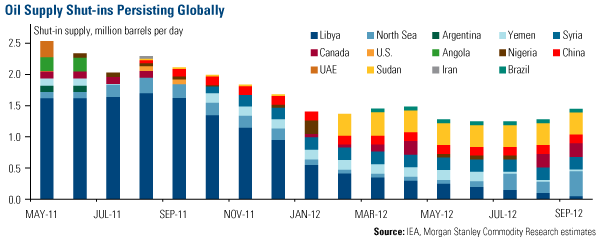Energy and Natural Resources Market Radar (September 10, 2012)

Strengths
- The Global Resources Fund (PSPFX) moved above its 200 day moving average this week.
- After China approved new infrastructure projects which supported the demand outlook in the world’s biggest consumer of copper, the metal gained over 3 percent this week making this the biggest weekly gain in 10 weeks.
- The Chinese government backed construction plans including roads and warehouses, according to statements on the National Development and Reform Commission’s (NDRC) website. Copper also rose after the ECB announced a bond- buying plan on Thursday to combat the debt crisis that threatens demand.
Weaknesses
- Consol Energy (CNX) announced it is idling two Appalachian coking coal operations in response to the slump in hard coking coal prices. U.S. coking coal exporters are the marginal cost producers for the seaborne market, so coking coal prices could start to see some support if further Appalachian shutdowns are announced. The current hard coking coal spot price is $159 per ton and has fallen 30 percent since mid-June.
- The worst U.S. drought in more than half a century helped drive down rates for Panamax vessels shipping grains to the lowest rates in more than 3 1/2 years as the drought results in a slump in cereal cargoes. The ships hauling about 60,000 metric tons of grains and other commodities including coal and iron ore slid 5.7 percent to $5,141 a day, the lowest since January 2009, according to data from the Baltic Exchange in London. The Baltic Dry Index, a wider measure of costs, fell 1.3 percent to 684 points. Global grain exports will fall the most in 27 years in the 2012-13 marketing year as the drought curbs shipments from the world’s largest supply country, according to U.S. Department of Agriculture data.
- China steel futures fell to an all-time low as poor demand in the world’s top steel market kept the pressure on prices, sending iron ore further below $90 a ton to its weakest level since October 2009. Iron ore prices have dropped 36 percent since early July, the main casualty among industrial commodities of China’s slowdown, and analysts say they have further to fall.
Opportunities
- China’s central government has announced an estimated $156 billion in infrastructure approvals in an effort to stimulate a stagnating domestic economy. The projects, spanning subway, highway, port, waterway, airport, and energy investments are scheduled to progress over the next four years.
- Meat consumption in China will continue to expand even as the economy slows, sustaining demand for feeds made from corn and soybeans, according to Cargill Inc., the biggest U.S. agricultural company. “We are looking at a mega-trend of increasing consumption of meat, milk, eggs,” Christopher Langholz, president of Cargill Animal Protein China, said in an interview, without giving specific forecasts. Rising incomes in China, the world’s second-largest economy, have increased demand for meat including pork, making the nation the largest buyer of soybeans, which are crushed to feed pigs and chicken. Soybeans and corn surged to records in Chicago last month as the worst U.S. drought in half a century cut supplies.
Threats
- China’s coal prices, already near a two-year low, are likely to fall further as industrial demand growth slows and imports add to pressure on domestic stocks, industry officials said Tuesday. Hou Wenjin, a coal industry official with the Shanxi provincial government, the country’s second biggest coal producing region, predicted China’s 2012 imports could top 200 million tons as coastal utilities lock in cheaper foreign supplies. “Overall inventories, at over 80 million tons, are still much higher than normal levels, so I don’t think there will big demand even for winter restocking,” he said.
- Peru’s mining industry will invest 33 percent less than previously expected next year as social unrest delays projects, according to the country’s National Society of Mining, Petroleum & Energy. Miners including Aluminum Corp. of China and HudBay Minerals will invest about $4 billion next year, compared with $6 billion planned previously and down from $7.2 billion this year, according to a presentation by the industry group. “We’re worried by what’s happening,” the group’s President Pedro Martinez said. “If investment continues to be scared away, many mines will reach the end of their productive lives and there will nothing we can do about it,” he added.












